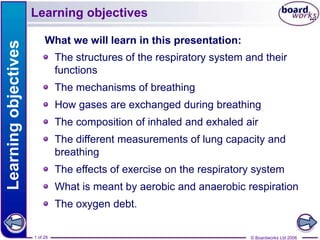
respiratory_system
- 1. © Boardworks Ltd 20061 of 28 Learningobjectives © Boardworks Ltd 20061 of 28 Learning objectives The structures of the respiratory system and their functions The mechanisms of breathing How gases are exchanged during breathing The composition of inhaled and exhaled air The different measurements of lung capacity and breathing The effects of exercise on the respiratory system What is meant by aerobic and anaerobic respiration The oxygen debt. What we will learn in this presentation:
- 2. © Boardworks Ltd 20062 of 28 The respiratory system
- 3. © Boardworks Ltd 20063 of 28 The nasal passages and lungs Air is drawn into the body via the nose or mouth. There are advantages to breathing through your nose: Air then travels through the larynx, trachea (windpipe), bronchi (one bronchus to each lung) and bronchioles to the alveoli, where oxygen passes into the bloodstream. the air is warmed so that it is closer to body temperature tiny hairs and mucus in the nose filter the air, preventing larger dust and pollen particles reaching the alveoli mucus moistens the air, making it easier for the alveoli to absorb.
- 4. © Boardworks Ltd 20064 of 28 When you breathe in: intercostal muscles between the ribs contract, pulling the chest walls up and out the diaphragm muscle below the lungs contracts and flattens, increasing the size of the chest the lungs increase in size, so the pressure inside them falls. This causes air to rush in through the nose or mouth. Mechanisms of breathing – inspiration Diaphragm contracts and moves down Intercostal muscles pull ribs up and out
- 5. © Boardworks Ltd 20065 of 28 Mechanisms of breathing – inspiration
- 6. © Boardworks Ltd 20066 of 28 Mechanisms of breathing – expiration When you breathe out: Intercostal muscles between the ribs relax so that the chest walls move in and down. The diaphragm muscle below the lungs relaxes and bulges up, reducing the size of the chest. The lungs decrease in size, so the pressure inside increases and air is pushed up the trachea and out through the nose or mouth. Diaphragm relaxes and bulges up Ribs move in and down
- 7. © Boardworks Ltd 20067 of 28 Mechanisms of breathing – expiration
- 8. © Boardworks Ltd 20068 of 28 Gas exchange at the alveoli The alveoli are bunches of tiny air sacks inside the lungs. Each individual sack is called an alveolus. When you breathe in, they fill with air. The alveoli are covered in tiny capillaries (blood vessels). Gases can pass through the thin walls of each alveolus and capillary, and into the blood stream. Gases can also pass from the blood stream, into the alveolus.
- 9. © Boardworks Ltd 20069 of 28 Gas exchange at the alveoli
- 10. © Boardworks Ltd 200610 of 28 Composition of inhaled and exhaled air Gas Amount in inhaled air Amount in exhaled air Oxygen Carbon dioxide Nitrogen Water vapour 17% 3% 79% Large amount 21% Very small amount 79% Small amount Why does mouth-to-mouth resuscitation work? What are the main differences between inhaled and exhaled air?
- 11. © Boardworks Ltd 200611 of 28 Measuring breathing Tidal volume is the amount you breathe in and out in one normal breath. Residual volume is the amount of air left in your lungs after you have breathed out as hard as you can. Minute volume is the volume of air you breathe in one minute. Respiratory rate is how many breaths you take per minute. Vital capacity is the maximum volume of air you can breathe out after breathing in as much as you can.
- 12. © Boardworks Ltd 200612 of 28 Measuring breathing
- 13. © Boardworks Ltd 200613 of 28 Calculating minute volume Question If you breathe 14 times in one minute (respiratory rate) and you breathe 0.5 litres in each breath, what is your minute volume? Answer: Minute volume = 14 × 0.5 litres = 7.0 litres Remember: You can calculate a person’s minute volume by multiplying the volume of air they breathe in one breath, by their respiratory (breathing) rate. Minute volume is the volume of air you breathe in one minute.
- 14. © Boardworks Ltd 200614 of 28 Breathing during exercise Muscle cell respiration increases – more oxygen is used up and levels of CO2 rise. The brain detects increasing levels of CO2 – a signal is sent to the lungs to increase breathing. Breathing rate and the volume of air in each breath increase. This means that more gaseous exchange takes place. The brain also tells the heart to beat faster so that more blood is pumped to the lungs for gaseous exchange. More oxygenated blood gets to the muscles and more CO2 is removed.
- 15. © Boardworks Ltd 200615 of 28 The effects of exercise on lung structures The respiratory muscles (the diaphragm and intercostals) get stronger, so they can make the chest cavity larger. This larger chest cavity means more air can be inspired, therefore increasing your vital capacity. More capillaries form around the alveoli, so more gaseous exchange can take place. In the long-term, regular exercise strengthens the respiratory system. Gas exchange can now take place more quickly meaning exercise can be maintained at a higher intensity for longer.